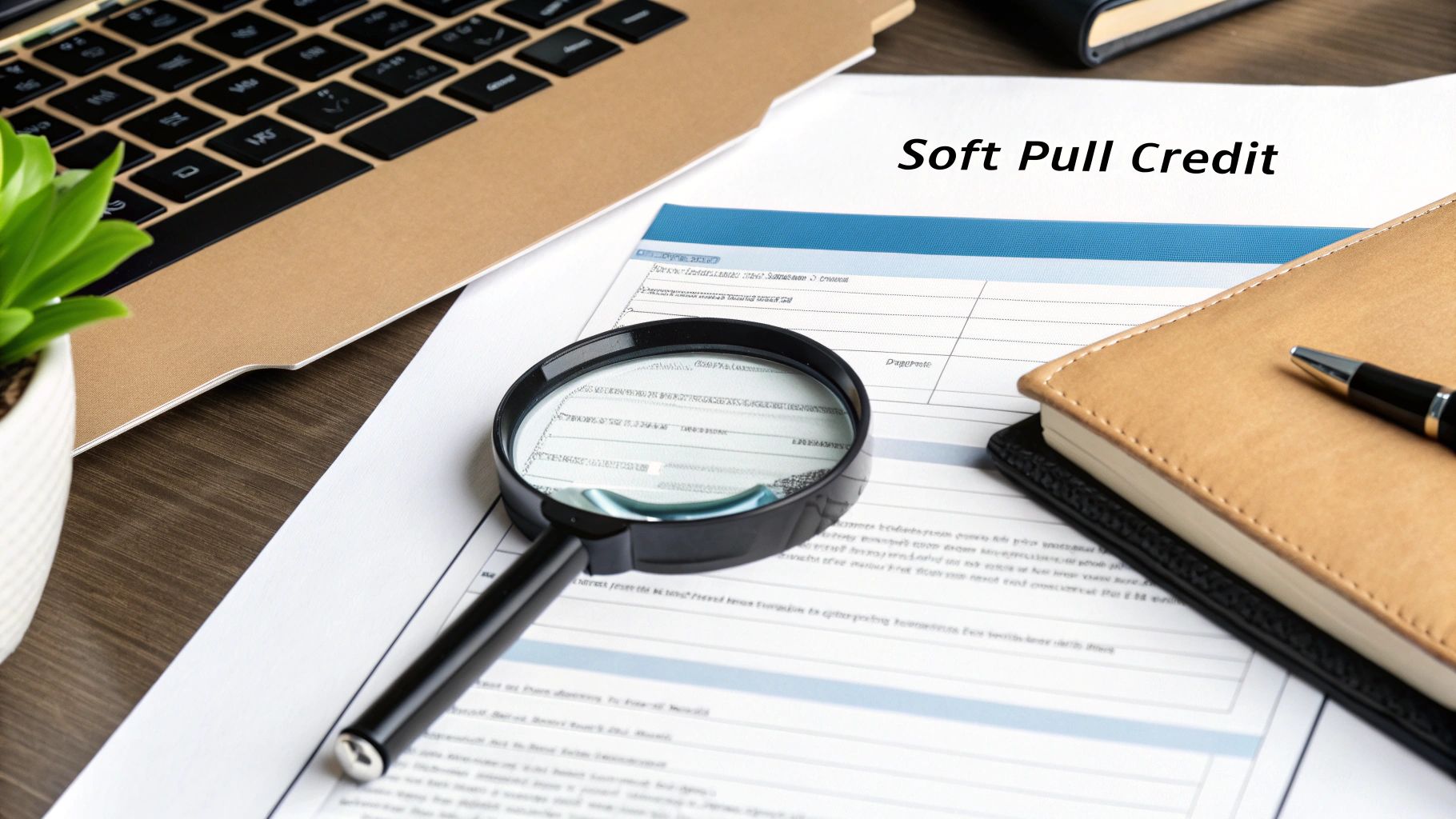Your Guide to Soft Pull Credit Checks

A soft pull credit check is a way for companies to get a sneak peek at your credit history without hurting your credit score. Think of it as window-shopping for your credit profile—they can look, but they can't touch.
What Is a Soft Pull Credit Check

Let's imagine your credit report is a detailed book about your financial life. A soft pull is like someone glancing at the table of contents or reading the summary on the back cover. They get the gist of your financial habits but don't dive into every single chapter.
This kind of inquiry is purely for informational purposes. It’s a world away from a "hard pull," which is what happens when you officially apply for something like a new loan or credit card. The key thing to remember is that soft pulls are completely harmless to your credit health.
The Purpose of a Soft Inquiry
So, why do companies even do this? They use soft pulls for a few different reasons, but none of them involve you directly asking for new credit. It gives them just enough information to make an initial judgment call.
Here are some common situations where a soft pull credit check comes into play:
This process is what lets you keep an eye on your own financial health without any negative side effects. For anyone building their financial story from the ground up, especially ITIN holders, getting comfortable with this is a huge first step. If you want to dive deeper, you can check out our guide on how to read and understand your ITIN credit report.
What Lenders See and What They Don't
A soft inquiry gives a lender a limited, high-level view of your credit profile. They'll see a modified version of your report, which usually includes things like your payment history on existing accounts and the different types of credit you have. It’s definitely not the full, detailed picture they'd get from a hard pull.
This difference is incredibly important. Because soft pulls are mainly for pre-approvals, background checks, and identity verification, they’ve become a risk-free part of managing your finances today.
The Difference Between Soft and Hard Pulls
If you've ever dealt with credit, you've likely heard the terms "soft pull" and "hard pull" thrown around. Getting a handle on what they mean is one of the most important things you can do for your financial well-being. It's not as complicated as it sounds.
Think of a soft pull credit check like someone window-shopping your credit profile. They can see the general gist from the outside—your overall financial health—but they aren't coming inside for a deep dive. A hard pull is the opposite. That's when a lender walks right into the store, pulls your complete file, and the visit gets officially logged.
This little story gets right to the heart of the matter: the impact. A soft pull is just a glance, a review that leaves no footprint on your credit score. A hard pull, because it's tied to an actual application for new credit, gets recorded as a formal inquiry and can temporarily ding your score.
Permission And Visibility
Another big difference comes down to permission. You don't always have to initiate a soft pull. For instance, a credit card company might run one to see if you qualify for a pre-approved offer they want to mail you.
A hard pull, however, almost always requires your direct, explicit consent. You provide that permission the moment you formally apply for a mortgage, a car loan, or a new credit card.
What other lenders see is also drastically different. When you look at your own credit report, you can see every inquiry—both soft and hard. But when a potential lender pulls your report, they can only see the hard inquiries. This is a huge deal. Multiple hard inquiries in a short time can look like a red flag to lenders, making them worry you're desperate for credit or taking on too much debt. Since soft pulls are invisible to them, they don't affect lending decisions one bit.
Want to go deeper on this topic? We have a whole article that unpacks whether checking your own credit hurts your score.

As the image shows, a soft pull—like when you check your own credit or get a pre-qualified offer—is a stress-free way to stay on top of your finances without any negative impact.
Soft Pull vs Hard Pull At A Glance
To make it even clearer, let's put these two types of credit checks side-by-side. Knowing these distinctions helps you make smarter choices, like shopping around for loan rates using pre-qualification tools that only use soft pulls, protecting your score in the process.
At the end of the day, while both types of inquiries can stay on your report for up to two years, only hard pulls are visible to lenders and factor into their decisions. Understanding when and why each is used is your first step toward building a solid financial foundation.
Common Scenarios for a Soft Pull Credit Check

You probably run into soft pull credit checks a lot more than you think. They’re constantly happening behind the scenes during all sorts of financial activities, often working in your favor without you having to lift a finger. Once you start recognizing where they pop up, the whole credit system feels a lot less mysterious.
The most common time you’ll see a soft pull is when you check your own credit. Every single time you log into a platform like itinscore or use another credit monitoring app to peek at your score, you’re kicking off a soft pull. This is a basic, essential part of staying on top of your financial health, and it’s designed so you can do it as often as you like without any penalty.
Another classic example is getting those pre-approved or pre-qualified offers in the mail for credit cards or loans. When a bank sends you a letter saying you look like a great fit for their latest card, it's because they've already run a quick soft pull to see if you meet their initial requirements.
Background Checks for Services and Employment
But soft pulls aren't just for lenders. All kinds of businesses use them as a quick, low-impact way to gauge risk before they start working with you.
For example, when you ask for a car insurance quote, the insurer often does a soft pull. They use details from your credit history to create a special credit-based insurance score, which can play a part in the premium they offer you. Landlords do it, too, often using a soft pull to confirm you are who you say you are and get a sense of your financial habits before handing over the keys.
Even some employers will run a soft pull as part of their background check process, but this is usually for jobs that involve handling money or sensitive financial information. And don’t worry—they always have to get your permission first, and it won't affect your score.
Why They Are So Widespread
So, why are soft pulls everywhere? The answer is simple: they protect you.
Soft pulls have become the go-to for everyday financial checks because they don't pose any risk to your credit score. This is a huge deal. It means you can monitor your own credit, get pre-qualified offers, or be screened by an insurance company without getting penalized for it. This system is all about consumer protection, empowering you to interact with your finances confidently. You can dive deeper into how these inquiries are used across the credit industry on The Points Guy.
Ultimately, this setup ensures you can shop for the best rates and keep an eye on your own credit without fearing that you'll damage your score in the process. It's a safe, smart way for information to be shared, which is a win for both you and the companies you do business with.
Ever wonder how a "pre-approved" credit card offer lands in your mailbox, seemingly out of nowhere? It's not a coincidence. It’s a common marketing practice driven by soft pull credit checks, and it’s how lenders find new customers without dinging anyone’s credit score.
Think of it as a quiet, large-scale scouting mission. Banks want to expand, but they need to be smart about who they offer credit to. They use soft pulls to prescreen millions of people at once, looking for those who fit a certain profile—maybe a specific credit score range or a solid history of paying bills on time.
This approach works out well for everyone. Lenders can send relevant offers to people who are actually likely to qualify. And you might get an offer for a credit card or loan that’s a great fit for you, all without the stress of a hard inquiry showing up on your report.
The Prescreening Process Explained
The path from being an anonymous consumer to receiving a personalized, pre-approved offer is a great example of data working efficiently behind the scenes.
Here’s a simplified look at how it unfolds:
This streamlined method has played a huge role in making credit more accessible. For example, soft pulls were a major factor in the credit card market's growth in 2021 and 2022. During that period, consumers with below-prime credit scores opened over 80 million new credit card accounts—a significant jump from the 63 million opened in the two years before. Soft pulls allowed issuers to find and pre-assess these customers without any risk. For a deeper dive, check out the Consumer Financial Protection Bureau's market report.
Using Soft Pulls to Improve Your Finances
Knowing the theory behind a soft pull credit check is great, but the real magic happens when you use that knowledge to actively better your financial health. You can stop being a passive observer of your credit and start making strategic moves that open doors—all without risking your score. This proactive mindset is what smart financial management is all about.
One of the best ways to put this into practice is "rate shopping." When you're looking for a new credit card or loan, you obviously want the best deal. But blindly applying to multiple lenders is a trap, as each formal application triggers a hard inquiry that can ding your credit score.
Instead, look for pre-qualification or pre-approval tools, which most major lenders now offer. These tools almost always use a soft pull to give you a solid idea of the rates and terms you'd likely receive. It’s like getting a personalized price list from several stores before you decide where to buy, letting you compare your options without any negative impact.
Monitor Your Credit Like a Pro
Beyond shopping for new credit, the single most powerful way to use soft pulls is by regularly monitoring your own credit. Every time you check your score through a service like itinscore or another credit monitoring platform, you're performing a soft pull on yourself. It's a simple, free action that's one of the most crucial financial habits you can build.
This simple habit gives you a huge advantage:
By making credit monitoring a routine, you take the driver's seat of your financial story. This consistent oversight helps you maintain a healthy profile and gives you the information you need to make smart adjustments. For a complete action plan, check out our detailed guide on how to improve your credit score. Turning knowledge into action is what builds lasting financial strength.
Frequently Asked Questions About Soft Pull Credit
Even after getting the basics down, it’s natural to have a few more questions about soft pull credit checks. Let's walk through some of the most common ones people ask. Getting these details ironed out will help you feel much more confident about how these checks work and what they mean for your credit report.
Can I See Who Ran a Soft Pull on My Report?
Yes, absolutely. When you pull your own credit report from one of the big three bureaus (Experian, TransUnion, or Equifax), you’ll see a complete list of every single inquiry—both hard and soft.
The soft inquiries are usually tucked away in their own section, often labeled something like "Promotional Inquiries" or "Account Review Inquiries." This transparency is great because it lets you see exactly which companies have pre-screened you for offers or which of your current creditors have taken a peek at your account. It’s your personal record of who’s looking at your information, even when it doesn't hurt your score.
How Long Does a Soft Pull Stay on My Credit Report?
Just like a hard inquiry, a soft pull will typically hang around on your credit report for up to two years. That might sound like a long time, but here’s the most important thing to remember: you are the only one who can see them.
So, you really don’t need to worry about them stacking up. Think of them as a personal historical log. For lenders making decisions, they might as well not even be there.
Will Lenders Think I Look Desperate If I Have Too Many Soft Pulls?
This is a really common fear, but the answer is a firm "no." Lenders won't think anything about the number of soft pulls you have, for one simple reason: they can't see them.
When a bank or credit card company performs a hard pull to review your official application, all of those soft inquiries are hidden from their view.
This is exactly why you're encouraged to check your own credit score as often as you want and to use pre-qualification tools when shopping for loans. These actions trigger soft pulls that are for your eyes only. You could have dozens of them without ever raising a single red flag.
The only inquiries that can signal risk to a lender are multiple hard inquiries in a short span of time. Soft pulls just aren't part of that equation.
Can a Soft Pull Ever Turn into a Hard Pull?
A soft pull can't just magically flip a switch and become a hard pull—they are two totally separate events. But a process that begins with a soft pull can definitely lead to a hard pull.
It usually unfolds like this:
The soft pull is like peeking through the doorway. Deciding to formally apply and walk through that door is what triggers the hard pull.
Take the first step toward building a strong financial future in the U.S. With itinscore, you can monitor your credit for free, get personalized advice, and find financial products designed just for ITIN holders. Sign up today and check your credit report instantly at itinscore.com.